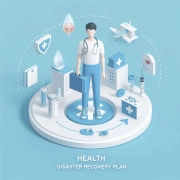NURS FPX 4060 Villa Health Disaster Recovery Plan Example
 NURS FPX 4060 Assessment 3 – Disaster Recovery Plan
NURS FPX 4060 Assessment 3 – Disaster Recovery Plan
Assignment Brief: NURS FPX 4060 Villa Health Disaster Recovery Plan
Assignment Instructions Overview:
This assignment challenges students to craft a meticulous and all-encompassing disaster recovery plan tailored for Villa Health, a hypothetical community on the brink of potential health crises. Through this undertaking, students will explore the aspects of public health principles, disaster preparedness, and the development of a comprehensive recovery strategy.
The Student’s Role:
In this assignment, students are tasked with adopting a holistic perspective. The emphasis lies in providing exhaustive speaker notes for each slide, offering in-depth expansions on definitions, objectives, and strategies elucidated in the presentation slides. The overarching aim is to showcase a profound understanding of disaster recovery planning principles and their practical application in the unique context of the Villa Health community.
NURS FPX 4060 Villa Health Disaster Recovery Plan Example
Slide 1: Title Slide
Disaster Recovery Plan for Vila Health Community
Presenter: [Your Name]
Date: [Current Date]
Course Number and Title: NURS FPX 4060: Disaster Recovery Plan
Slide 1 Speaker Notes:
Good [morning/afternoon/evening], everyone. My name is Abigail, and I am here to present the Disaster Recovery Plan for the Vila Health Community. Today, we will looking at the key components of the plan, addressing health disparities, and improving access to community services after a disaster. Let’s begin.
Slide 2: Introduction and Objectives
- Definition of Disaster Recovery Plan
- Strategic framework crafted to guide our community’s response and rehabilitation efforts in the aftermath of a significant disaster or crisis.
- Roadmap to ensure a coordinated and effective approach to mitigate health disparities and enhance access to essential services.
- Objectives of the Presentation
- Determinants of Health
- Identifying Community Needs
- Tools and Resources for Implementation
- Social Justice and Cultural Sensitivity
- Impact of Health and Governmental Policy on the Recovery Efforts
- Strategies for Communication and Interprofessional Collaboration
Slide 2 Speaker Notes:
Good afternoon, everyone. I’m delighted to guide you through our comprehensive Disaster Recovery Plan tailored for the Vila Health Community. Today, our mission is to not only present a plan but to actively engage in a collective effort to fortify our community’s resilience post-disaster.
Defining Disaster Recovery Plan:
A Disaster Recovery Plan is a strategic framework crafted to guide our community’s response and rehabilitation efforts in the aftermath of a significant disaster or crisis. It’s a roadmap that ensures a coordinated and effective approach to mitigate health disparities and enhance access to essential services.
Objectives:
Determinants of Health:
These determinants include economic status, health services accessibility, physical environment factors, and policy dynamics. Understanding these influencers is pivotal in tailoring our recovery efforts to the unique needs of our community members.
Identifying Community Needs:
Our focus extends to conducting a meticulous assessment of the community’s needs. This involves engaging with community members, understanding their economic, social, and cultural nuances, and identifying specific areas that require targeted interventions.
Tools and Resources for Implementation:
This includes leveraging the MAP-IT framework (Mobilize, Assess, Plan, Implement, Track), understanding the change of command structure, and identifying key members of our disaster recovery team who will play pivotal roles in the plan’s execution.
Social Justice and Cultural Sensitivity:
Recognizing the principles of social justice and cultural sensitivity is embedded in our recovery plan. These principles will guide our actions, ensuring that equity, fairness, and respect for cultural norms are central to our recovery initiatives.
Impact of Health and Governmental Policy:
Health and governmental policies shape our recovery efforts significantly with specific examples such as the FEMA policies, like the Presidential Policy Directive 8 and the Disaster Recovery Reform Act of 2018. As such, understanding their implications on our recovery strategy is fundamentally important.
Strategies for Communication and Interprofessional Collaboration:
Communication is the backbone of effective disaster recovery. It is therefore important to put in place strategies to overcome potential communication barriers during a disaster, as well as foster interprofessional collaboration among diverse stakeholders, ensuring a harmonized and efficient recovery effort.
Slide 3: Determinants of Health
Definition of Determinants of Health
- Fundamental factors that wield considerable influence over the well-being of individuals within our community.
- Vila Health Community Factors:
- Economic Status
- Health Services Access
- Physical Environment
- Policy Making
How these factors affect the recovery plan
- The effectiveness of our plan hinges on our ability to address these determinants comprehensively.
Slide 3 Speaker Notes:
Economic Status:
The economic status of our community members is a key determinant. Income levels, employment opportunities, and financial stability directly impact access to healthcare, nutrition, and overall health. Crafting a recovery plan that addresses economic disparities is paramount to ensuring equitable health outcomes for everyone.
Access to Health Services:
Another critical determinant is the accessibility of health services. Understanding how easily community members can access medical care, especially during and after a disaster, informs our recovery plan’s strategies to enhance service availability.
Physical Environment:
The surroundings in which our community members live play a significant role in their health. From the quality of air and water to the safety of neighborhoods, our recovery plan will aim to mitigate environmental risks and enhance the overall well-being of our community.
Policy Making:
Policies crafted at local, state, and national levels have a direct impact on health. Some of the existing policies that may either facilitate or impede our recovery efforts. Recognizing the role of policy in shaping health outcomes allows us to advocate for necessary changes and align our recovery strategies with overarching health objectives.
Slide 4: Community Needs and Recovery Plan
- Purpose of the Recovery Plan
- Derived Needs:
- Favorable Public Policies
- Improved Public Services
- Enhanced Health Services, Education, Transport, and Communication
Slide 4 Speaker Notes:
Purpose of the Recovery Plan:
Our recovery plan is not a generic one-size-fits-all approach; it’s a dynamic strategy uniquely designed for the Vila Health Community. The primary purpose is to diminish health disparities and amplify access to services post-disaster. As we dig deeper into the community’s needs, keep in mind that our recovery plan is a proactive response to ensure the well-being of each resident.
Derived Needs:
The needs we’ve derived from our overarching purpose are multifaceted and interconnected. We’re looking at:
Favorable Public Policies:
Advocating for policies that align with our recovery objectives. This includes policies that address economic disparities, promote community well-being, and streamline the recovery process.
Improved Public Services:
Enhancing the quality and accessibility of public services is at the forefront of our plan. From healthcare facilities to emergency response services, our aim is to bolster the overall public service infrastructure.
Health Services:
Our recovery plan places a strong emphasis on improving health services. This involves ensuring that healthcare facilities are not only accessible but equipped to meet the diverse healthcare needs of the community.
Education:
Education is a cornerstone of community resilience. Our plan includes initiatives to bolster educational resources, ensuring that residents are informed and empowered to navigate post-disaster challenges.
Transport and Communication:
Efficient transport and communication are vital during recovery. Our plan addresses these needs by proposing strategies to improve transportation systems and establish effective communication channels within the community.
Slide 5: Tools To Implement the Recovery Plan
- Introduction to MAP-IT Framework
- Change of Command
- Disaster Recovery Members and Their Roles
- General Timeline for Recovery Efforts
Slide 5 Speaker Notes:
Introducing the MAP-IT Framework:
Our first tool is the MAP-IT framework – Mobilize, Assess, Plan, Implement, Track. This proven approach will serve as our guiding compass throughout the recovery process. Each phase is meticulously designed to ensure a systematic and comprehensive response. Mobilizing collaborative partners, assessing community needs, planning for health equity, implementing strategies aligned with our objectives, and continuously tracking progress – this framework encapsulates the essence of our Recovery Plan.
Change of Command:
Another critical tool in our arsenal is the Change of Command. Establishing a clear hierarchy and delineating roles is imperative for effective disaster recovery. We’ll introduce the leaders and team members who will spearhead the implementation of our plan. This clarity ensures seamless communication, swift decision-making, and efficient resource allocation during the recovery phase.
Disaster Recovery Team Members and Roles:
Let’s familiarize ourselves with the individuals who make up our Disaster Recovery Team and understand their specific roles. From executive leaders to on-the-ground responders, each member plays a crucial part in the success of our plan. Highlighting these roles ensures that everyone is aligned with their responsibilities, promoting synergy within the team.
General Recovery Timeline:
Time is of the essence in disaster recovery. This timeline serves as a roadmap, indicating key milestones and the expected duration for each phase. Having a clear sense of the timeline allows us to stay on track and respond promptly to evolving needs.
Slide 6: Social Justice and Cultural Sensitivity
- Definition of Social Justice and Cultural Sensitivity
- Application in Healthcare
- Ensuring Equity in Recovery Efforts
- Recognizing and Respecting Cultural Norms
Slide 6 Speaker Notes:
Importance of Social Justice:
Social justice forms the bedrock of our recovery strategy. It’s not just about responding to a disaster; it’s about responding equitably. By prioritizing fairness and impartiality, our Recovery Plan aims to create a level playing field for every resident.
Cultural Sensitivity in Healthcare:
Healthcare is deeply intertwined with cultural norms and beliefs. Our plan recognizes the diversity within the Vila Health Community and places a premium on cultural sensitivity. Our plan ensures that healthcare services are not only accessible but also tailored to meet the unique needs of each demographic.
Equity Across Demographics:
As we navigate the discussion on social justice and cultural sensitivity, keep in mind that our goal is to ensure equity across all demographics. Whether it’s economic status, linguistic diversity, or cultural practices, our plan is designed to embrace diversity and promote inclusivity in every aspect of the recovery process.
Respecting Cultural Norms:
Each community has its own set of cultural norms. Our plan takes a proactive stance in respecting these norms, recognizing them not as obstacles but as integral aspects of community identity. By intertwining cultural sensitivity into our recovery efforts, we are not just rebuilding; we are rebuilding with an acute awareness of and respect for the rich cultural diversity that makes up the Vila Health Community.
Slide 7: Health and Governmental Policies
- Overview of FEMA Policies
- Example: Presidential Policy Directive 8
- Disaster Recovery Reform Act of 2018
- Impact on Recovery Efforts and Shared Responsibility
Slide 7 Speaker Notes:
Overview of FEMA Policies:
FEMA, the Federal Emergency Management Agency, plays a pivotal role in disaster response. FEMA’s policies have a lot of significance in coordinating and facilitating effective recovery. Understanding these policies is key to aligning our efforts with national strategies for disaster management.
Example: Presidential Policy Directive 8:
Within the landscape of FEMA policies, we can spotlight one key directive for instance – Presidential Policy Directive 8. This directive emphasizes the importance of a whole-community approach to emergency management. By examining its tenets, we gain insights into the principles that advocate for collaboration, shared responsibility, and community engagement in disaster recovery.
Disaster Recovery Reform Act of 2018:
A significant piece of legislation that shapes our approach is the Disaster Recovery Reform Act of 2018. This act introduces reforms aimed at enhancing the nation’s preparedness for future disasters setting the stage for a more resilient and responsive recovery process.
Impact on Recovery Efforts and Shared Responsibility:
These policies don’t just exist in isolation; they significantly impact our recovery efforts. Adherence to these policies will certainly ensure a more coordinated response, fostering a sense of shared responsibility among various stakeholders. Recognizing the interconnectedness of our efforts with these policies is essential for a seamless and effective recovery.
Slide 8: Overcoming Communication Barriers
- Types of Communication Barriers
- Strategies:
- Language Boards
- Medical Translators
- Mobile Apps and Alarms
- Social Media
Slide 8 Speaker Notes:
Types of Communication Barriers:
Communication breakdowns can impede the effectiveness of our recovery efforts. These can range from coordination issues in radio communication to challenges in establishing contact with first responders during the initial hours.
Strategies for Overcoming Barriers:
Recognizing these barriers is just the first step. These strategies are not theoretical; they are actionable approaches designed to ensure seamless communication in the face of adversity.
Language Boards:
In diverse communities like Vila Health, linguistic diversity is a reality. Language boards emerge as a practical tool for bridging language gaps, ensuring that critical information reaches every individual, regardless of their primary language.
Medical Translators:
Beyond basic communication, healthcare often involves distinctive discussions. Medical translators play a crucial role in ensuring that medical information is accurately conveyed. Integrating medical translators into our communication strategy enhances clarity and precision in healthcare communication.
Mobile Apps and Alarms:
In the age of technology, leveraging mobile apps and alarms becomes indispensable. These tools not only facilitate rapid communication but also serve as real-time alerts for emergencies. Our plan incorporates these technological solutions to bolster communication efficacy.
Social Media:
Social media platforms have proven to be powerful communication channels. Our plan embraces these platforms strategically, recognizing their potential to disseminate information rapidly to a broad audience.
Slide 9: Enhancing Interprofessional Collaboration (IPC)
- Importance of IPC
- Professions Involved in Disaster Recovery
- Strategies:
- Delegation of Duties
- IPC Education
- Detailed Disaster Plan
Slide 9 Speaker Notes:
Importance of IPC in Disaster Recovery:
Disaster recovery involves a multitude of professions, ranging from healthcare workers and administrators to emergency responders. Recognizing the importance of seamless collaboration among these diverse professions is key.
Various Professions Involved:
The disaster scenario at Vila Health Community involves a spectrum of professions, including healthcare professionals, EMTs, police, and fire department teams. Understanding the roles of each participant lays the groundwork for effective collaboration.
Strategies for Effective Collaboration:
Collaboration doesn’t happen by chance; it requires intentional strategies. Specific strategies in our plan are employed to foster effective IPC. From delegation of duties to the implementation of IPC education in schools, each strategy contributes to a more cohesive and coordinated recovery process.
Detailed Planning and Education:
IPC isn’t just a spontaneous occurrence; it’s a result of meticulous planning and education, where the roles of each participant are clearly defined. Additionally, education becomes a catalyst for improving interprofessional communication and understanding.
Impact on Disaster Relief Team and Community:
The ripple effects of effective IPC extend beyond the immediate recovery team to influence individuals, families, and aggregates within the community.
Slide 10: Proposed Disaster Recovery Plan and Benefits
- Purpose and Goals of the Proposed Plan
- Reducing Health Disparities
- Improving Health Access
- Inclusive Care Irrespective of Demographics
Slide 10 Speaker Notes:
Purpose and Goals:
Our recovery plan is not just a document; it’s a comprehensive strategy crafted with a singular purpose – to enhance the resilience of the Vila Health Community in the face of disasters. The overarching goals of our plan, focus on reducing health disparities, improving health access, and ensuring inclusive care for all community members.
Reducing Health Disparities:
Health disparities often stem from unequal access to resources. Our plan actively addresses this issue by prioritizing the needs of the most vulnerable groups within the community.
Improving Health Access:
Access to healthcare is a fundamental right, especially during the recovery phases. Our plan delineates strategic actions aimed at improving access to essential health services. From infrastructure enhancements to targeted healthcare initiatives, our plan paves the way for a more accessible healthcare environment.
Inclusive Care for All:
One size does not fit all. Our recovery plan is designed to be inclusive, considering the diverse demographics of the Vila Health Community. Our strategies ensure that every individual, irrespective of their background, receives personalized and culturally sensitive care.
Governmental Policies and Legislation:
The recovery plan is not isolated from external factors. It is bound to be influenced by governmental policies, such as the Presidential Policy Directive 8 and the Disaster Recovery Reform Act of 2018. Understanding these policies is crucial, as they shape the framework within which our recovery efforts unfold.
Shared Responsibility and Impact:
Recovery is a collective effort. Shared responsibility is highly encouraged throughout the plan, where the community actively participates in the recovery process within the Vila Health Community.
Slide 11: Barriers to Safety, Health, and Recovery Efforts
- Identifying Cultural, Economic, and Social Barriers
- Challenges in Collaboration and Communication
- Addressing Obstacles for Effective Recovery
Slide 11 Speaker Notes:
Identifying Cultural, Economic, and Social Barriers:
Successful recovery hinges on a proper understanding of the diverse factors at play including the cultural, economic, and social barriers that might pose challenges. Recognizing these barriers is the first step towards devising targeted strategies to navigate them successfully.
Challenges in Collaboration and Communication:
Collaboration and communication are the backbone of effective recovery. However, challenges can arise, hindering the seamless flow of information and coordination.
Addressing Obstacles for Effective Recovery:
Identifying obstacles is not sufficient; we must proactively address them to ensure the success of our recovery plan. Our plan incorporates a multifaceted approach, including specific steps and interventions tailored to tackle these barriers head-on, from cultural competency training to targeted communication strategies, in order to overcome these obstacles.
Slide 12: Conclusion
- Summary of Key Points
- Emphasis on Economic Status, Physical Environment, and Policies
- Strategies for Cultural Sensitivity, Communication, and IPC
Slide 12 Speaker Notes:
Summary of Key Points:
We’ve journeyed through the determinants of health, community needs, tools for implementation, considerations of social justice and cultural sensitivity, and the impact of health and governmental policies. Each element plays a vital role in crafting a comprehensive recovery plan.
Emphasis on Economic Status, Physical Environment, and Policies:
The economic status of the community, the condition of the physical environment, and the influence of policies are foundational elements. Our recovery plan places significant emphasis on addressing these factors, recognizing their pivotal role in the overall well-being of the community.
Strategies for Cultural Sensitivity, Communication, and IPC:
We’ve discussed strategies for ensuring cultural sensitivity, overcoming communication barriers, and enhancing interprofessional collaboration. These strategies are not just theoretical concepts but actionable steps embedded in our recovery plan. They underscore our commitment to inclusivity, effective communication, and collaborative efforts.
Slide 13: References
Centers for Disease Control and Prevention. (n.d.). Coping with a disaster or traumatic event. https://emergency.cdc.gov/coping/index.asp
Centers for Disease Control and Prevention. (n.d.). Emergency preparedness and response. https://emergency.cdc.gov/
Centers for Disease Control and Prevention. (2011). Guidance on microbial contamination in previously flooded outdoor areas. U.S. Department of Health and Human Services. https://www.cdc.gov/nceh/ehs/publications/guidance_flooding.htm
Federal Emergency Management Agency (FEMA). (n.d.). National Flood Insurance Program. FloodSmart. https://www.floodsmart.gov/
Calonge, N., Brown, L., & Downey, A. (2020). Evidence-based practice for public health emergency preparedness and response: Recommendations from a national academies of sciences, engineering, and medicine report. JAMA, 324(7), 629-630.
Khan, Y., O’Sullivan, T., Brown, A., Tracey, S., Gibson, J., Généreux, M., Henry, B., & Schwartz, B. (2018). Public health emergency preparedness: A framework to promote resilience. BMC Public Health, 18(1), 1344.
Madrigano, J., Chandra, A., Costigan, T., & Acosta, J. D. (2017). Beyond disaster preparedness: Building a resilience-oriented workforce for the future. International Journal of Environmental Research and Public Health, 14(12), 114.
Ready.gov. (n.d.). Plan ahead for disasters. https://www.ready.gov/
U.S. Department of Homeland Security. (n.d.). Plan and prepare for disasters. http://www.dhs.gov/topic/plan-and-prepare-disasters
Xue, C.-L., Shu, Y.-S., Hayter, M., & Lee, A. (2020). Experiences of nurses involved in natural disaster relief: A meta‐synthesis of qualitative literature. Journal of Clinical Nursing, 29(23-24), 4514-4531.
U.S. Department of Health and Human Services, Office of Disease Prevention and Health Promotion. (n.d.). Healthy People 2030. https://health.gov/healthypeople
U.S. Department of Health and Human Services, Office of Disease Prevention and Health Promotion. (n.d.). Program planning. Health People 2020. https://www.healthypeople.gov/2020/tools-and-resources/Program-Planning
MAP-IT: A guide to using Healthy People 2020 in your community. (n.d.). Information on MAP-IT.
Detailed Assessment Instructions for the NURS FPX 4060 Villa Health Disaster Recovery Plan Example
Assessment 3 Instructions: Disaster Recovery Plan
Top of Form
Bottom of Form
- PRINT
- Develop a disaster recovery plan to lessen health disparities and improve access to community services after a disaster. Then, develop and record a 10-12 slide presentation (please refer to the PowerPoint tutorial) of the plan with audio and speaker notes for the Vila Health system, city officials, and the disaster relief team.
As you begin to prepare this assessment, you are encouraged to complete the Disaster Preparedness and Management activity. The information gained from completing this activity will help you succeed with the assessment as you think through key issues in disaster preparedness and management in the community or workplace. Completing activities is also a way to demonstrate engagement.
Introduction
Nurses perform a variety of roles and their responsibilities as health care providers extend to the community. The decisions we make daily and in times of crisis often involve the balancing of human rights with medical necessities, equitable access to services, legal and ethical mandates, and financial constraints. In the event of a major accident or natural disaster, many issues can complicate decisions concerning the needs of an individual or group, including understanding and upholding rights and desires, mediating conflict, and applying established ethical and legal standards of nursing care. As a nurse, you must be knowledgeable about disaster preparedness and recovery to safeguard those in your care. As an advocate, you are also accountable for promoting equitable services and quality care for the diverse community.
Nurses work alongside first responders, other professionals, volunteers, and the health department to safeguard the community. Some concerns during a disaster and recovery period include the possibility of death and infectious disease due to debris and/or contamination of the water, air, food supply, or environment. Various degrees of injury may also occur during disasters, terrorism, and violent conflicts.
To maximize survival, first responders must use a triage system to assign victims according to the severity of their condition/prognosis in order to allocate equitable resources and provide treatment. During infectious disease outbreaks, triage does not take the place of routine clinical triage.
Trace-mapping becomes an important step to interrupting the spread of all infectious diseases to prevent or curtail morbidity and mortality in the community. A vital step in trace-mapping is the identification of the infectious individual or group and isolating or quarantining them. During the trace-mapping process, these individuals are interviewed to identify those who have had close contact with them. Contacts are notified of their potential exposure, testing referrals become paramount, and individuals are connected with appropriate services they might need during the self-quarantine period (CDC, 2020).
An example of such disaster is the COVID-19 pandemic of 2020. People who had contact with someone who were in contact with the COVID-19 virus were encouraged to stay home and maintain social distance (at least 6 feet) from others until 14 days after their last exposure to a person with COVID-19. Contacts were required to monitor themselves by checking their temperature twice daily and watching for symptoms of COVID-19 (CDC, 2020). Local, state, and health department guidelines were essential in establishing the recovery phase. Triage Standard Operating Procedure (SOP) in the case of COVID-19 focused on inpatient and outpatient health care facilities that would be receiving, or preparing to receive, suspected, or confirmed COVID- 19 victims. Controlling droplet transmission through hand washing, social distancing, self-quarantine, PPE, installing barriers, education, and standardized triage algorithm/questionnaires became essential to the triage system (CDC, 2020; WHO, 2020).
This assessment provides an opportunity for you to apply the concepts of emergency preparedness, public health assessment, triage, management, and surveillance after a disaster. You will also focus on evacuation, extended displacement periods, and contact tracing based on the disaster scenario provided.
Note: Complete the assessments in this course in the order in which they are presented.
Preparation
When disaster strikes, community members must be protected. A comprehensive recovery plan, guided by the MAP-IT (Mobilize, Assess, Plan, Implement, Track) framework, is essential to help ensure everyone’s safety. The unique needs of residents must be assessed to lessen health disparities and improve access to equitable services after a disaster. Recovery efforts depend on the appropriateness of the plan, the extent to which key stakeholders have been prepared, the quality of the trace-mapping, and the allocation of available resources. In a time of cost containment, when personnel and resources may be limited, the needs of residents must be weighed carefully against available resources.
In this assessment, you are a community task force member responsible for developing a disaster recovery plan for the Vila Health community using MAP-IT and trace-mapping, which you will present to city officials and the disaster relief team.
To prepare for the assessment, complete the Vila Health: Disaster Recovery Scenario simulation.
In addition, you are encouraged to complete the Disaster Preparedness and Management activity. The information gained from completing this activity will help you succeed with the assessment as you think through key issues in disaster preparedness and management in the community or workplace. Completing activities is also a way to demonstrate engagement.
Begin thinking about:
- Community needs.
- Resources, personnel, budget, and community makeup.
- People accountable for implementation of the disaster recovery plan.
- Healthy People 2020 goals and 2030 objectives.
- A timeline for the recovery effort.
You may also wish to:
- Review the MAP-IT (Mobilize, Assess, Plan, Implement, Track) framework, which you will use to guide the development of your plan:
- Mobilize collaborative partners.
- Assess community needs.
- Plan to lessen health disparities and improve access to services.
- Implement a plan to reach Healthy People 2020 goals or 2030 objectives.
- Track community progress.
. Review the assessment instructions and scoring guide to ensure that you understand the work you will be asked to complete.
Note: As you revise your writing, check out the resources listed on the Writing Center’s Writing Support page.
Note: If you require the use of assistive technology or alternative communication methods to participate in this activity, please contact DisabilityServices@capella.edu to request accommodations.
Instructions
Every 10 years, The U.S. Department of Health and Human Services and the Office of Disease Prevention and Health Promotion release information on health indicators, public health issues, and current trends. At the end of 2020, Healthy People 2030 was released to provide information for the next 10 years. Healthy People 2030 provides the most updated content when it comes to prioritizing public health issues; however, there are historical contents that offer a better understanding of some topics. Disaster preparedness is addressed in Healthy People 2030, but a more robust understanding of MAP-IT, triage, and recovery efforts is found in Healthy People 2020. For this reason, you will find references to both Healthy People 2020 and Healthy People 2030 in this course.
Complete the following:
- Develop a disaster recovery plan for the Vila Health community that will lessen health disparities and improve access to services after a disaster. Refer back to the Vila Health: Disaster Recovery Scenario to understand the Vila Health community.
. Assess community needs.
. Consider resources, personnel, budget, and community makeup.
. Identify the people accountable for implementation of the plan and describe their roles.
. Focus on specific Healthy People 2020 goals and 2030 objectives.
. Include a timeline for the recovery effort.
- Apply the MAP-IT (Mobilize, Assess, Plan, Implement, Track) framework to guide the development of your plan:
. Mobilize collaborative partners.
. Assess community needs.
. Use the demographic data and specifics related to the disaster to identify the needs of the community and develop a recovery plan. Consider physical, emotional, cultural, and financial needs of the entire community.
. Include in your plan the equitable allocation of services for the diverse community.
. Apply the triage classification to provide a rationale for those who may have been injured during the train derailment. Provide support for your position.
. Include in your plan contact tracing of the homeless, disabled, displaced community members, migrant workers, and those who have hearing impairment or English as a second language in the event of severe tornadoes.
- Plan to lessen health disparities and improve access to services.
- Implement a plan to reach Healthy People 2020 goals and 2030 objectives.
- Track and trace-map community progress.
. Use the CDC’s Contract Tracing Resources for Health Departments as a template to create your contact tracing.
. Describe the plan for contact tracing during the disaster and recovery phase.
- Develop a slide presentation of your disaster recovery plan with an audio recording of you presenting your assessment of the Vila Health: Disaster Recovery Scenario for city officials and the disaster relief team. Be sure to also include speaker notes.
Presentation Format and Length
You may use Microsoft PowerPoint (preferred) or other suitable presentation software to create your slides and add your voice-over along with speaker notes. If you elect to use an application other than PowerPoint, check with your instructor to avoid potential file compatibility issues.
Be sure that your slide deck includes the following slides:
- Title slide.
- Recovery plan title.
- Your name.
- Date.
- Course number and title.
- References (at the end of your presentation).
Your slide deck should consist of 10–12 content slides plus title and references slides. Use the speaker’s notes section of each slide to develop your talking points and cite your sources as appropriate. Be sure to also include a transcript that matches your recorded voice-over. The transcript can be submitted on a separate Word document. Make sure to review the Microsoft PowerPoint tutorial for directions.
The following resources will help you create and deliver an effective presentation:
- Record a Slide Show With Narration and Slide Timings.
- This Microsoft article provides steps for recording slide shows in different versions of PowerPoint, including steps for Windows, Mac, and online.
- Microsoft Office Software.
- This Campus page includes tip sheets and tutorials for Microsoft PowerPoint.
- PowerPoint Presentations Library Guide.
- This library guide provides links to PowerPoint and other presentation software resources.
- SoNHS Professional Presentation Guidelines [PPTX].
- This presentation, designed especially for the School of Nursing and Health Sciences, offers valuable tips and links, and is itself a PowerPoint template that can be used to create a presentation.
Supporting Evidence
Cite at least three credible sources from peer-reviewed journals or professional industry publications within the past 5 years to support your plan.
Graded Requirements
The requirements outlined below correspond to the grading criteria in the scoring guide, so be sure to address each point:
- Describe the determinants of health and the cultural, social, and economic barriers that impact safety, health, and recovery efforts in the community.
- Consider the interrelationships among these factors.
- Explain how your proposed disaster recovery plan will lessen health disparities and improve access to community services.
- Consider principles of social justice and cultural sensitivity with respect to ensuring health equity for individuals, families, and aggregates within the community.
- Explain how health and governmental policy impact disaster recovery efforts.
- Consider the implications for individuals, families, and aggregates within the community of legislation that includes, but is not limited to, the Americans with Disabilities Act (ADA), the Robert T. Stafford Disaster Relief and Emergency Assistance Act, and the Disaster Recovery Reform Act (DRRA).
- Present specific, evidence-based strategies to overcome communication barriers and enhance interprofessional collaboration to improve the disaster recovery effort.
- Consider how your proposed strategies will affect members of the disaster relief team, individuals, families, and aggregates within the community.
- Include evidence to support your strategies.
- Organize content with clear purpose/goals and with relevant and evidence-based sources (published within 5 years).
- Slides are easy to read and error free. Detailed audio and speaker notes are provided. Audio is clear, organized, and professionally presented.
- Develop your presentation with a specific purpose and audience in mind.
- Adhere to scholarly and disciplinary writing standards and APA formatting requirements.
Additional Requirements
Before submitting your assessment, proofread all elements to minimize errors that could distract readers and make it difficult for them to focus on the substance of your presentation.
Competencies Measured
By successfully completing this assessment, you will demonstrate your proficiency in the following course competencies and scoring guide criteria:
- Competency 1: Analyze health risks and health care needs among distinct populations.
- Describe the determinants of health and the cultural, social, and economic barriers that impact safety, health, and disaster recovery efforts in a community.
- Competency 2: Propose health promotion strategies to improve the health of populations.
- Present specific, evidence-based strategies to overcome communication barriers and enhance interprofessional collaboration to improve disaster recovery efforts.
- Competency 3: Evaluate health policies, based on their ability to achieve desired outcomes.
- Explain how health and governmental policy impact disaster recovery efforts.
- Competency 4: Integrate principles of social justice in community health interventions.
- Explain how a proposed disaster recovery plan will lessen health disparities and improve access to community services.
- Competency 5: Apply professional, scholarly communication strategies to lead health promotion and improve population health.
- Organize content with clear purpose/goals and with relevant and evidence-based sources (published within 5 years).
- Slides are easy to read and error free. Detailed audio, transcript, and speaker notes are provided. Audio is clear, organized, and professionally presented.
Resources: Disaster Preparedness and Management
Top of Form
Bottom of Form
- PRINT
- The following activity provides the context and information needed to complete the assessment:
- Vila Health: Disaster Recovery Scenario.
The following articles will help you better understand public health assessment and surveillance as well as the nurse’s role in disaster preparedness and management in the workplace and community.
- Centers for Disease Control and Prevention. (n.d.). Coping with a disaster or traumatic event . https://emergency.cdc.gov/coping/index.asp
- Centers for Disease Control and Prevention. (n.d.). Emergency preparedness and response . https://emergency.cdc.gov/
- Centers for Disease Control and Prevention. (2011). Guidance on microbial contamination in previously flooded outdoor areas . U.S. Department of Health and Human Services. https://www.cdc.gov/nceh/ehs/publications/guidance_flooding.htm
- Federal Emergency Management Agency (FEMA). (n.d.). National Flood Insurance Program . FloodSmart. https://www.floodsmart.gov/
- Calonge, N., Brown, L., & Downey, A. (2020). Evidence-based practice for public health emergency preparedness and response: Recommendations from a national academies of sciences, engineering, and medicine report. JAMA, 324(7), 629630.
- Khan, Y., O’Sullivan, T., Brown, A., Tracey, S., Gibson, J., Généreux, M., & Henry, B., & Schwartz, B. (2018). Public health emergency preparedness: A framework to promote resilience. BMC Public Health, 18(1), 1344.
- Madrigano, J., Chandra, A., Costigan, T., & Acosta, J. D. (2017). Beyond disaster preparedness: Building a resilience-oriented workforce for the future. International Journal of Environmental Research and Public Health, 14(12), 114.
- Ready.gov. (n.d.). Plan ahead for disasters . https://www.ready.gov/
- U.S. Department of Homeland Security. (n.d.). Plan and prepare for disasters . http://www.dhs.gov/topic/plan-and-prepare-disasters
- Xue, C.-L., Shu, Y.-S., Hayter, M., & Lee, A. (2020). Experiences of nurses involved in natural disaster relief: A meta‐synthesis of qualitative literature. Journal of Clinical Nursing, 29(23-24), 45144531.
The following resources will help in developing a disaster recovery plan.
- U.S. Department of Health and Human Services, Office of Disease Prevention and Health Promotion. (n.d.). Healthy People 2030 . https://health.gov/healthypeople
- U.S. Department of Health and Human Services, Office of Disease Prevention and Health Promotion. (n.d.). Program planning . Health People 2020. https://www.healthypeople.gov/2020/tools-and-resources/Program-Planning
- Information on MAP-IT, a guide to using Healthy People 2020 in your community.
Resources: Multimedia Recording and Academic Resources
Top of Form
Bottom of Form
The following resources will help you create and deliver an effective presentation.
- Conquering Death by PowerPoint: The Seven Rules of Proper Visual Design.
- A video primer on presentation design.
- Approximate run time: 45:00.
. Creating a Presentation: A Guide to Writing and Speaking.
- This video addresses the primary areas involved in creating effective audiovisual presentations. You can return to this resource throughout the process of creating your presentation to view the tutorial appropriate for you at each stage.
. Microsoft Office Software.
- This Campus resource includes tip sheets and tutorials for Microsoft PowerPoint.
. PowerPoint Presentations Library Guide.
- This library guide provides links to PowerPoint and other presentation software resources.
. SoNHS Professional Presentation Guidelines [PPTX].
Scholarly Writing and APA Style
Use the following resources to improve your writing skills and find answers to specific questions.
. Academic Honesty & APA Style and Formatting.
. APA Module.
. Writing Center.
Library Research
Use the following resources to help with any required or self-directed research you do to support your coursework.
. BSN Program Library Research Guide.
. Journal and Book Locator Library Guide.
. Capella University Library.
. Library Research and Information Literacy Skills.
ePortfolio
. ePortfolio.
. Online ePortfolio Guidelines [PDF].
Give Your Academic Journey a Boost with our Top Nursing Paper Writing Services!
Are you facing the challenges of difficult or controversial nursing topics? Look no further! At ReliablePapers.com, we take pride in being your top-notch nursing writing service. Our team of expert nursing essay writers is dedicated to delivering personalized and original nursing papers that guarantee the best grades.
Navigating through complex topics, managing tight deadlines, or following specific instructions? Relax, because we’ve got you covered. Whether you require a custom nursing research paper or assistance with your nursing assignments, our professionals are here to lend a helping hand.
How We Can Assist You:
Our pro nursing writers craft outstanding nursing essay papers from scratch, addressing any topic, meeting any deadline, and adhering to your specific instructions. At ReliablePapers.com, we understand the significance of your academic success.
Why Choose Us?
- Affordable Prices: Our online nursing papers are priced affordably, ensuring accessibility for all college students.
- Expert Writers: Let our skilled writers make your paper perfect, providing the expertise needed for exceptional results.
- Originality Guaranteed: Bid farewell to plagiarized papers. Our nursing experts create original and customized nursing essays for your academic success.
- Easy Ordering Process: Ready to place your order? It’s hassle-free! Visit our “Place Order” page, provide paper details, proceed to checkout, and your order will be assigned to a suitable expert.
How to Get Started:
Ready to save time and secure the grades you deserve? Visit our “Place Order” page, fill in your paper details, proceed to checkout, and trust us to make your nursing papers perfect. Don’t wait until the last minute; fill in your requirements and let our experts deliver your work ASAP.
Why Trust Our Professionals?
Professionals at ReliablePapers.com stay updated with the latest nursing trends, ensuring your nursing research paper stands out. Our skilled writers offer the best nursing writing services, meeting your desires and ensuring timely submissions.
As a nursing student, balancing assignments and class participation can be overwhelming. Seeking help enables you to submit research on time and ensures exceptional performance in your nursing research papers and assignments. Trust ReliablePapers.com for your academic success! Our online nursing essays are unmatched both in quality and affordability.
Hire an Expert Paper Writer on Any Subject, Any Topic, Any Deadline! Submit your paper instructions by placing your order here to get started!

 NURS FPX 8010 Assessment 2 Strategic Plan Appraisal
NURS FPX 8010 Assessment 2 Strategic Plan Appraisal

 NURS FPX 4040 Assessment 1: Nursing Informatics in Health Care
NURS FPX 4040 Assessment 1: Nursing Informatics in Health Care NURS FPX 4040 Assessment 2: Protected Health Information (PHI), Privacy, Security, and Confidentiality Best Practice
NURS FPX 4040 Assessment 2: Protected Health Information (PHI), Privacy, Security, and Confidentiality Best Practice NURS FPX 4040 Assessment 3: Evidence-Based Proposal and Annotated Bibliography on Technology in Nursing
NURS FPX 4040 Assessment 3: Evidence-Based Proposal and Annotated Bibliography on Technology in Nursing NURS FPX 4030 Assessment 4: Remote Collaboration and Evidence-Based Care
NURS FPX 4030 Assessment 4: Remote Collaboration and Evidence-Based Care Capella NURS FPX 4050 Assessment 4: Final Care Coordination Plan
Capella NURS FPX 4050 Assessment 4: Final Care Coordination Plan Assignment: NHS-FPX400 Developing a Health Care Perspective Assessment 3
Assignment: NHS-FPX400 Developing a Health Care Perspective Assessment 3 NURS FPX 6107 Curriculum Design Development and Evaluation Assignment Brief
NURS FPX 6107 Curriculum Design Development and Evaluation Assignment Brief NURS FPX 4060 Assessment 3 – Disaster Recovery Plan
NURS FPX 4060 Assessment 3 – Disaster Recovery Plan NURS FPX 4060 Practicing in the Community to Improve Population Health Assignment Brief
NURS FPX 4060 Practicing in the Community to Improve Population Health Assignment Brief